Activities for Children
Books for Young children with a World War I theme:
The Donkey Man / Glyn Harper, illustrated by Bruce Potter
Caesar the Anzac Dog / Patricia Potter, illustrated by Bruce Potter
The Little Red Hen and the Great War / Jennifer Beck illustrated by Robyn Belton
Le Quesnoy: the story of the town New Zealand saved / Glynn Harper, illustrated by Jenny Cooper
Only a Donkey / Celestine Walters and Patricia Mullens
The Red Poppy / David Hill, illustrated by Fifi Colston
Horses
10,000 New Zealand horses went to war – they carried men but mostly they pulled carts carrying essential supplies – food, water, fuel, weapons and ammunition. Only a few of these horses were able to return to New Zealand because of the fear they may bring back diseases.
Donkeys of Gallipoli
Camels
Dogs
The Donkey Man / Glyn Harper, illustrated by Bruce Potter
Caesar the Anzac Dog / Patricia Potter, illustrated by Bruce Potter
The Little Red Hen and the Great War / Jennifer Beck illustrated by Robyn Belton
Le Quesnoy: the story of the town New Zealand saved / Glynn Harper, illustrated by Jenny Cooper
Only a Donkey / Celestine Walters and Patricia Mullens
The Red Poppy / David Hill, illustrated by Fifi Colston
Animals in World War I
Animals played a part in World War I. It is difficult to think about animals being involved in war but many were.Horses
10,000 New Zealand horses went to war – they carried men but mostly they pulled carts carrying essential supplies – food, water, fuel, weapons and ammunition. Only a few of these horses were able to return to New Zealand because of the fear they may bring back diseases.
 This photograph of Bess taken on the banks of the Jordan River, 1918 Photograph courtesy of New Zealand Mounted Rifles. |
Bess came Home Bess, whose real name was Zelma, was born in 1910 in Martinborough and bred by A.D. McMaster who donated her to the war effort. She became the mount of Guy Powles of the New Zealand Mounted Rifles, and saw action in the Middle East and in 1918 went with him to France. After the war she was taken to England and this was considered quarantine enough for her to come home. One day in October 1934, while Colonel Powles was riding his faithful mare, "she suddenly decided to lie down and die there and then." Bess was buried where she lay and a cairn was erected at the site near Bulls. Bulls Museum have a permanent display on Bess and the other horses. Click here to download an PDF of Bess to colour-in |
Donkeys of Gallipoli
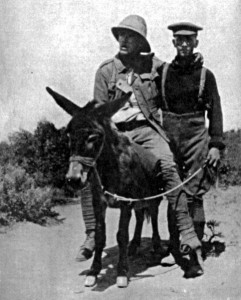 |
Horses were of little use in the harsh terrain of Gallipoli with its steep hills and stony ground. Donkeys, however coped well with these conditions. They were used to carry water and supplies. Private John Simpson, an Australian stretcher bearer was the first to use donkeys to bring wounded men down from the hills and his story is often told. He had several donkeys – including Murphy, Duffy and Abdul. Other medics began to use donkeys in this way including New Zealander Dick Henderson. Click here to download a PDF of Murphy to colour-in. |
Camels
.jpg) |
Camels unlike horses have the ability to go for days without water. This made them very suitable for work in the desert campaigns of the First World War. Two New Zealand companies were part of the Imperial Camel Corps and fought in Sinai and Palestine. They rode their camels to get to the scene of battle and would dismount to fight on foot. Despite their stubbornness the New Zealanders became very fond of their camels. Here Alice the camel is loaded with everything needed for the Brigade Headquarters. Click here to download a PDF of Alice to colour-in. |
| Dogs were a huge help to soldiers on the battlefields as they were used to run messages, act as patrol dogs, and find wounded men among many other tasks. They also reminded the soldiers of home and kept them company. Paddy was the Irish terrier mascot of the Wellington Battalion, serving in both Gallipoli and the Western Front. He was often in the thick of the action at Gallipoli, barking and scurrying around as bullets whistled over his head. He earned several promotions and became a Scout Sergeant-Major. It is believed he came home to New Zealand after the war. Click here to download a PDF of Paddy to colour-in. |
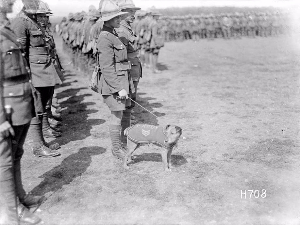 |
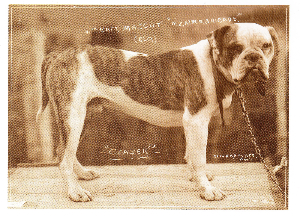 |
Caesar was the official mascot of 4th Battalion (A company) New Zealand Rifle Brigade.He trained as a Red Cross dog and helped in the field by finding wounded soldiers. Sadly Caesar was killed in action in 1916. A book - Caesar the Anzac Dog / Patricia Potter, illustrated by Bruce Potter has been written about him Click here to download a PDF of Caesar to colour-in. |
Cats
Cats are not very good at delivering messages nor can they carry men and equipment but they reminded the soldiers of home and were often to be found in the trenches and hospitals during the war. Snowy was the mascot and friend of the men of the New Zealand Tunneling Company.
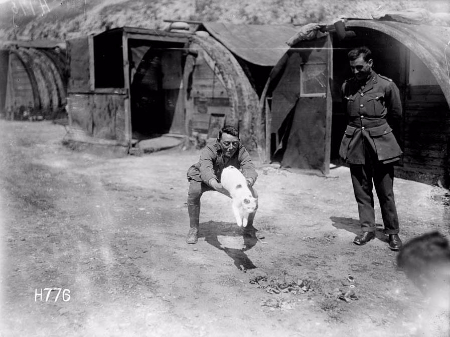
Click here to download a PDF of Snowy to colour-in.
Ideas from the Scout's Hall
WW1 How do we make sense of this for children?For many years Janet has been running a very popular Gallipoli experience in her local Scout Hall. The children stay overnight, stage a mock landing using ping pong balls as ammunition and eat authentic food. Along the way they begin to understand what it was like to be a soldier 100 years ago.Here are some of Janet's suggestions for using our five senses:
|
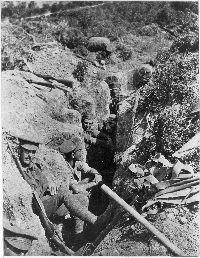 |
 Login
Login
